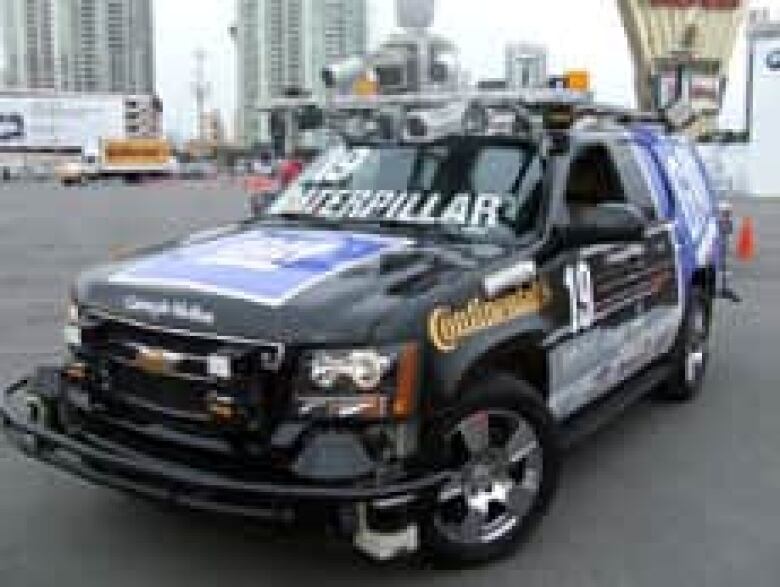Self-driving cars are only 10 years away
GM exec says auto and electronics industries are growing closer
LAS VEGAS The stuff of science-fiction movies is just around the bend, according to General Motors, with fully automated, self-driving cars expected to be on the road within the next 10 years.

That was the message put forward by GM chief executive officer Rick Wagoner in his keynote address at the Consumer Electronics Show on Tuesday afternoon. The speech was the last keynote of the annual Las Vegas show, but also the first ever by a car maker in the event's 41 years.
Wagoner said GM's presence at the show was indicative of how the auto and electronics industries are growing closer to each other. Ever since automakers installed the first electric starters in the 1910s, cars have been moving closer toward becoming consumer electronics products, to the point where they are now almost like computers.
"The auto and electronics industries go back a long way," he said. "If the automobile were to be invented today, I'm pretty sure it would debut right here at CES. It is a highly sophisticated example of consumer electronics."
Wagoner showed off a pair of silver, electric-powered concept cars, the sporty Chevy Volt, which he drove onto the stage, and the Cadillac Provoq SUV, which also uses hydrogen fuel-cell technology.
He said the development of hybrid alternative-fuel vehicles is a priority for GM because of growing global concerns over oil supplies.
"The auto industry can no longer rely exclusively on oil to supply the industry's future energy requirements," he said. "It is critical to our business destiny and our obligation to society to develop alternative means of propulsion to meet the world's demands for our products, which is growing at a very rapid pace."
Wagoner said that by 2012, more than half of all new GM cars would be able to run on ethanol. If all U.S. automakers committed to the same goal, the country could cut its oil intake by 10 per cent, he said.
He also urged oil companies to open up new ethanol pumps, as only about one per cent of gas stations currently have them.
GM also plans to release 16 gas-electric hybrid vehicles over the next two years, he said.
Aside from the changing environmental technology going into the building of cars, Wagoner also gave a sneak preview of some of the electronics going into them.
GM's OnStar in-vehicle communications and monitoring system will soon introduce applications that can be activated over a cellphone. In the "very short term," subscribers to the service will be able to unlock or even start their vehicles remotely with their mobile device.
A number of 2008 vehicles also have warning systems that alert drivers when they are swerving out of a lane, as well as blind-spot sensors that can see other vehicles when the driver can't.
Some of those features were on display in the parking lot outside the Las Vegas Convention Center, where GM and Pittsburgh's Carnegie Mellon University were showing off the recent winner of a U.S. government-sponsored robot car race. The GM SUV, nicknamed the "Boss," in November won the Defense Advanced Research Projects Agency Urban Challenge, where fully automated vehicles had to complete a 96-kilometre race in a simulated city environment in six hours.
The 11 entrant vehicles had to be fully automated with no human interaction or remote control, and drove a course that was similar to full urban conditions complete with cars driven by real human stunt drivers.
The Boss, which took a year to design, uses a combination of radar, laser sensors, cameras and GPS positioning to do its driving.
The vehicle's real-world applications are numerous, according to Chris Urmson, who was the university's director of technology on the project.
GM vehicles already incorporate some of the technology used in the Boss, such as the lane and blind-spot detectors, and vehicles of the future will continue to introduce its other advanced features.
"It's going to be phased in gradually," Urmson said. "But we expect a fully autonomous, self-driving car to be on the road in the next decade."
Such cars are likely to be allowed on highways first, rather than on city streets, because driving there is more straightforward, he said. That will free drivers up to do other things during the trip.

"That means during a long road trip, I can read, watch a movie or even sleep," Urmson said.
A conference attendee who listened in on the interviewquipped: "I guess this also means I won't need a driver's licence."
One additional benefit to robot cars will be extra safety, said Bakhtiar Litkouhi, manager of vehicle control systems for GM. After all, vehicles have no emotions.
"There will be no more road rage because it's logical. It's like Mr. Spock."












_(720p).jpg)


 OFFICIAL HD MUSIC VIDEO.jpg)
.jpg)



























































































